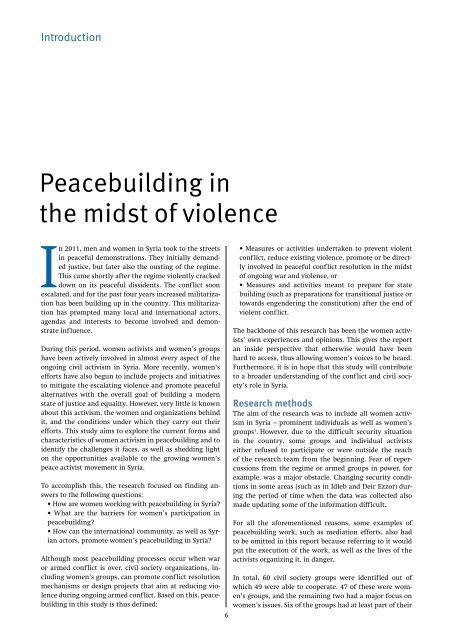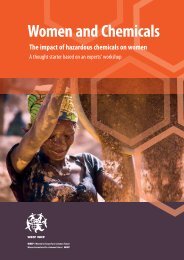future now”
YAO19
YAO19
You also want an ePaper? Increase the reach of your titles
YUMPU automatically turns print PDFs into web optimized ePapers that Google loves.
Introduction<br />
Peacebuilding in<br />
the midst of violence<br />
In 2011, men and women in Syria took to the streets<br />
in peaceful demonstrations. They initially demanded<br />
justice, but later also the ousting of the regime.<br />
This came shortly after the regime violently cracked<br />
down on its peaceful dissidents. The conflict soon<br />
escalated, and for the past four years increased militarization<br />
has been building up in the country. This militarization<br />
has prompted many local and international actors,<br />
agendas and interests to become involved and demonstrate<br />
influence.<br />
During this period, women activists and women’s groups<br />
have been actively involved in almost every aspect of the<br />
ongoing civil activism in Syria. More recently, women’s<br />
efforts have also begun to include projects and initiatives<br />
to mitigate the escalating violence and promote peaceful<br />
alternatives with the overall goal of building a modern<br />
state of justice and equality. However, very little is known<br />
about this activism, the women and organizations behind<br />
it, and the conditions under which they carry out their<br />
efforts. This study aims to explore the current forms and<br />
characteristics of women activism in peacebuilding and to<br />
identify the challenges it faces, as well as shedding light<br />
on the opportunities available to the growing women’s<br />
peace activist movement in Syria.<br />
To accomplish this, the research focused on finding answers<br />
to the following questions:<br />
• How are women working with peacebuilding in Syria?<br />
• What are the barriers for women’s participation in<br />
peacebuilding?<br />
• How can the international community, as well as Syrian<br />
actors, promote women’s peacebuilding in Syria?<br />
Although most peacebuilding processes occur when war<br />
or armed conflict is over, civil society organizations, including<br />
women’s groups, can promote conflict resolution<br />
mechanisms or design projects that aim at reducing violence<br />
during ongoing armed conflict. Based on this, peacebuilding<br />
in this study is thus defined:<br />
6<br />
• Measures or activities undertaken to prevent violent<br />
conflict, reduce existing violence, promote or be directly<br />
involved in peaceful conflict resolution in the midst<br />
of ongoing war and violence, or<br />
• Measures and activities meant to prepare for state<br />
building (such as preparations for transitional justice or<br />
towards engendering the constitution) after the end of<br />
violent conflict.<br />
The backbone of this research has been the women activists’<br />
own experiences and opinions. This gives the report<br />
an inside perspective that otherwise would have been<br />
hard to access, thus allowing women’s voices to be heard.<br />
Furthermore, it is in hope that this study will contribute<br />
to a broader understanding of the conflict and civil society’s<br />
role in Syria.<br />
Research methods<br />
The aim of the research was to include all women activism<br />
in Syria – prominent individuals as well as women’s<br />
groups 1 . However, due to the difficult security situation<br />
in the country, some groups and individual activists<br />
either refused to participate or were outside the reach<br />
of the research team from the beginning. Fear of repercussions<br />
from the regime or armed groups in power, for<br />
example, was a major obstacle. Changing security conditions<br />
in some areas (such as in Idleb and Deir Ezzor) during<br />
the period of time when the data was collected also<br />
made updating some of the information difficult.<br />
For all the aforementioned reasons, some examples of<br />
peacebuilding work, such as mediation efforts, also had<br />
to be omitted in this report because referring to it would<br />
put the execution of the work, as well as the lives of the<br />
activists organizing it, in danger.<br />
In total, 60 civil society groups were identified out of<br />
which 49 were able to cooperate. 47 of these were women’s<br />
groups, and the remaining two had a major focus on<br />
women’s issues. Six of the groups had at least part of their



